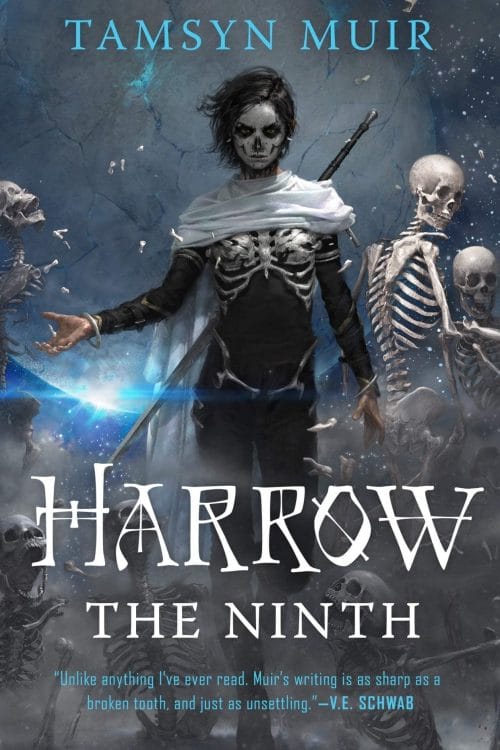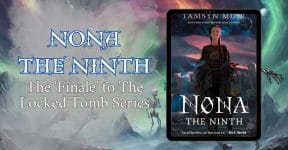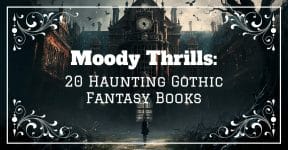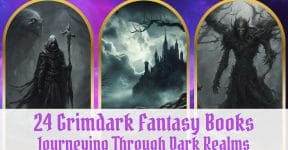Diving into the enigmatic, labyrinthine world of Tamsyn Muir’s ‘Harrow the Ninth’ is a journey that defies expectations and challenges the boundaries of traditional storytelling. As a follow-up to the acclaimed ‘Gideon the Ninth,’ this second installment delves deeper into the realm of necromancy. Thus unveiling a tale of fractured memories, cosmic mysteries, and a protagonist struggling with the complexities of identity and destiny. In this review, we’ll explore the intricacies of ‘Harrow the Ninth’. Navigating its unique narrative structure, the evolution of its central characters, and the dark, genre-defying landscape that sets it apart in the realm of speculative fiction.
Harrow the Ninth is the second novel in the Locked Tomb trilogy. The trilogy features the following novels:
- Gideon the Ninth (2019)
- Harrow the Ninth (2020)
- Nona the Ninth (2022)
Table of Contents [CLICK HERE TO OPEN]
Harrow the Ninth

She answered the Emperor’s call.
She arrived with her arts, her wits, and her only friend.
In victory, her world has turned to ash.
After rocking the cosmos with her deathly debut, Tamsyn Muir continues the story of the penumbral Ninth House in Harrow the Ninth, a mind-twisting puzzle box of mystery, murder, magic, and mayhem. Nothing is as it seems in the halls of the Emperor, and the fate of the galaxy rests on one woman’s shoulders.
Harrowhark Nonagesimus, last necromancer of the Ninth House, has been drafted by her Emperor to fight an unwinnable war. Side-by-side with a detested rival, Harrow must perfect her skills and become an angel of undeath — but her health is failing, her sword makes her nauseous, and even her mind is threatening to betray her.
Sealed in the gothic gloom of the Emperor’s Mithraeum with three unfriendly teachers, hunted by the mad ghost of a murdered planet, Harrow must confront two unwelcome questions: is somebody trying to kill her? And if they succeeded, would the universe be better off?
Our Review
Harrow the Ninth by Tamsyn Muir is a mind-bending, genre-defying sequel to Gideon the Ninth, continuing the extraordinary journey of necromancer Harrowhark Nonagesimus. This second installment plunges readers into a surreal, labyrinthine narrative that challenges perceptions of reality, life, and death.
Muir’s writing style is unique and intricate, filled with dark humor, vivid descriptions, and a complex narrative structure. The story oscillates between past and present, keeping readers on their toes as they navigate through Harrow’s fragmented memories and current struggles. The intricate storytelling, though at times challenging, adds depth to the world-building and the enigmatic characters.
The development of Harrowhark’s character is a highlight of the novel. Her internal conflict, vulnerabilities, and strengths are exquisitely portrayed, making her a compelling, albeit enigmatic, protagonist. The supporting characters are equally intriguing, with their own mysteries and backstories that unfold gradually, adding layers to the intricate plot.
Muir’s imaginative blend of science fiction, fantasy, and horror creates a unique universe that’s both macabre and captivating. The story’s elements of necromancy, complex magic systems, and the exploration of the afterlife are woven together seamlessly. This offers a richly detailed and eerie backdrop for the narrative.
However, Harrow the Ninth demands the reader’s full attention. The nonlinear storytelling and complex plot can be disorienting, requiring a degree of patience and dedication to fully grasp the intricacies of the tale. Some readers might find the non-linear structure and dense prose challenging. Those who enjoy unraveling mysteries and piecing together a complex narrative will find it rewarding.
In conclusion, Harrow the Ninth is a bold and ambitious sequel that delves deeper into the mysteries introduced in the first book. It’s a complex, darkly imaginative, and thought-provoking novel that pushes the boundaries of the science fiction and fantasy genres. Readers who appreciate unconventional storytelling and intricate world-building will find Harrow the Ninth a compelling and memorable read.
Frequently Asked Questions
What is Harrow the Ninth about?
Harrow the Ninth is the sequel to Gideon the Ninth and follows the story of Harrowhark Nonagesimus. A necromancer grappling with a fractured memory and her role in the battle against a mysterious force threatening the universe.
Do I need to read Gideon the Ninth prior to reading Harrow the Ninth?
It’s highly recommended to read Gideon the Ninth before delving into Harrow the Ninth. The events and characters from the first book play a significant role in the sequel and provide essential context for understanding the narrative.
Does Harrow the Ninth answer the questions left from Gideon the Ninth?
While Harrow the Ninth elaborates on the events of the first book, it also introduces new mysteries and expands the universe. Some questions from the previous book are answered, but others arise, keeping the storyline engaging and mysterious.
Is Harrow the Ninth part of a series?
Yes, Harrow the Ninth is the second book in The Locked Tomb trilogy, following Gideon the Ninth and preceeding “Alecto the Ninth.”
Praise for the series:
Harrow the Ninth, an Amazon pick for Best SFF of 2020 and the New York Times and USA Today bestselling sequel to Gideon the Ninth, turns a galaxy inside out as one necromancer struggles to survive the wreckage of herself aboard the Emperor’s haunted space station.
The Locked Tomb is a 2023 Hugo Award Finalist for Best Series!
“Lesbian necromancers explore a haunted gothic palace in space! Decadent nobles vie to serve the deathless emperor! Skeletons!” —Charles Stross on Gideon the Ninth
“Unlike anything I’ve ever read.” —V.E. Schwab on Gideon the Ninth
“Deft, tense and atmospheric, compellingly immersive and wildly original.” —The New York Times on Gideon the Ninth
In the end, Tamsyn Muir’s Harrow the Ninth is more than a book; it’s an adventure waiting to be embarked upon, an exploration of a world that stretches the boundaries of imagination and leaves an indelible mark on all who dare to delve into its pages.






